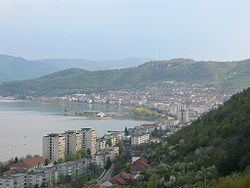Status Municipality Climate Cfb Local time Monday 11:28 AM | Time zone EET (UTC+2) Population 9,692 (2011) | |
 | ||
Weather 11°C, Wind SW at 3 km/h, 54% Humidity | ||
Orșova ([ˈorʃova]; German: Orschowa, Hungarian: Orsova, Serbian: Оршава/Oršava, Bulgarian: Орсово, Polish: Orszawa, Czech: Oršava, Turkish: Adakale) is a port city on the Danube river in southwestern Romania's Mehedinți County. It is one of four localities in the county located in the Banat historical region. It is situated just above the Iron Gates, on the spot where the Cerna River meets the Danube.
Contents
Map of Or%C8%99ova 225200, Romania
Demographics
At the 2011 census, 95.2% of inhabitants were Romanians, 1.3% Czechs, 1% Roma, 0.9% Germans, 0.7% Serbs and 0.5% Hungarians.
History
Economy
The town is a center for the extraction of bentonite, chromium, and granite. The industry is centered on energy production (the hydroelectric plant), shipbuilding and engine manufacturing, assembly parts for electricity production, textiles, and the processing of feldspar, asbestos, quartz, talc, wood, etc.
The Orșova shipyard was constructed in 1890 and like a small reparation shop for the vessels which participated to the navigable channel from Iron Gate Romania- Sip Yugoslavia and had a continuously development along time, with a spectacular development after the year 1991 when was changed the name and also the organizational profile.
A wind farm is being developed in the city territory, on a hill nearby (at 4.5 km from the agglomeration); the first turbines became active there in 2009.
